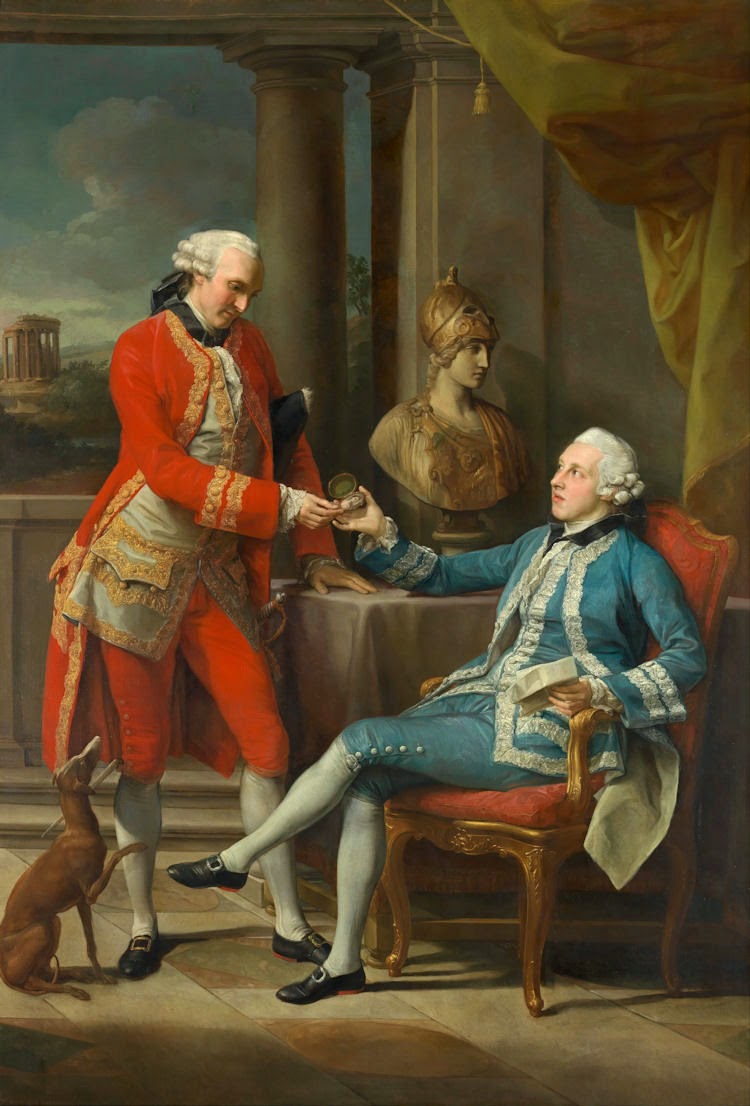Pompeo Girolamo Batoni (25 January 1708, Lucca – 4 February 1787, Rome), among the most celebrated Italian painters in his day, his work incorporated elements of the French Rococo, Bolognese classicism, and a nascent Neoclassicism. Batoni strove to move beyond the stylistic excesses of the Rococo by gathering inspiration from classical antiquity and from the work of artists such as Raphael and Poussin; as such he was a precursor of Neoclassicism. His patrons and collectors included royalty and popes and the aristocracy from all over Europe; he is especially remembered today for his portraits of British aristocrats, painted while they were in Rome, in the midst of making "the Grand Tour".
%2B1778.jpg) |
| Francis Basset, later 1st Baron de Dunstanville and Basset, 1778. |
 |
| Philip Metcalfe, circa 1766-67. |
 |
| Edmund Rolfe, 1761. |
 |
| Richard Aldworth Neville, later 2nd Baron Braybrooke, 1773. |
The son of a goldsmith, at the age of nineteen he moved to Rome, where he apprenticed with Agostino Masucci, Sebastiano Conca, and Francesco Imperiali. His career began to take off in 1732 when, by chance, Forte Gabrielli di Gubbio, count of Baccaresca took cover from a storm under the portico of the Palazzo dei Conservatori on the Capitoline Hill, and met the artist drawing there. Impressed, he asked to visit Batoni's studio. He subsequently commissioned the young artist to paint a new altarpiece for the Gabrielli chapel in San Gregorio Magno al Celio. The resulting "Madonna on a Throne with child and four Saints and Blesseds of the Gabrielli family" was widely admired, and Batoni soon began to receive other important commissions.
 |
| William Fermor, 1758. |
%2C%2BChamberlain%2Bto%2Bthe%2BKing%2Bof%2BPrussia%2C%2B1771.jpg) |
| Portrait of Baron François de Chambrier, Chamberlain to the King of Prussia, 1771. |
 |
| The Honorable Lionel Damer, 1772 or 1773. |
 |
| Portrait of a Gentleman, 1762. |
In 1741, he was inducted into the Accademia di San Luca. He was soon a highly fashionable painter and greatly in demand for portraits, particularly by the British traveling through Rome, who commissioned portraits posed in settings rife with antiquities and ruins; there are records of over two hundred portraits by Batoni of visiting British patrons. From 1759 Batoni lived in a large house at 25, Via Bocca di Leone in Rome, which included a studio as well as exhibition rooms and a drawing academy.
 |
| Richard Milles, circa 1760s. |
%2C%2BLater%2B1st%2BEarl%2BTalbot_1773.jpg) |
| John Talbot, later 1st Earl Talbot, 1773. |
 |
| Thomas Dundas, later 1st Baron Dundas, 1764. |
 |
| Edward Howard, 1766. |
He was married twice, first to Caterina Setti in 1729, and five years after her death, he married Lucia Fattori in 1747. He had twelve children; three of his sons assisted in his studio. His last years were plagued with ill-health, and he died at the age seventy-nine in Rome, and was buried at his parish church of San Lorenzo in Lucina.
 |
| Sir Sampson Gideon and an unidentified companion, 1767 |
 |
| John Monck, 1764. |
 |
| Sir Gregory Page-Turner, 3rd Baronet, 1768. |

%2B1778.png)


I love the inclusion of canines in many of his paintings. So many of these men were especially handsome. Was the painter trying to flatter the subjects?
ReplyDeleteWho knows. Of course it's the job of a portrait painter to at least - subtly - flatter the subject; most of us could use just a little "improvement".
Delete